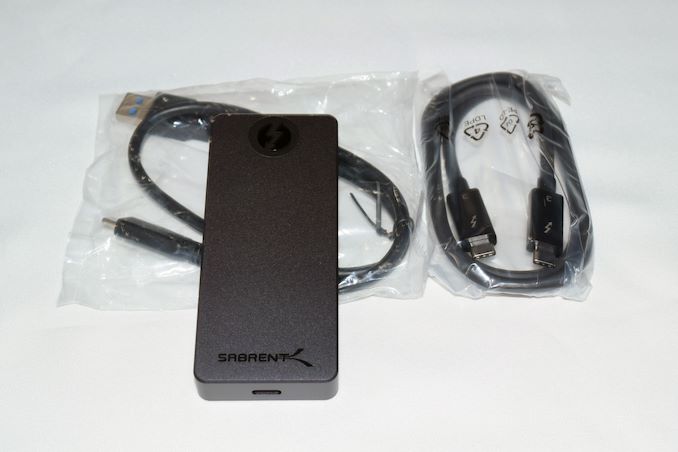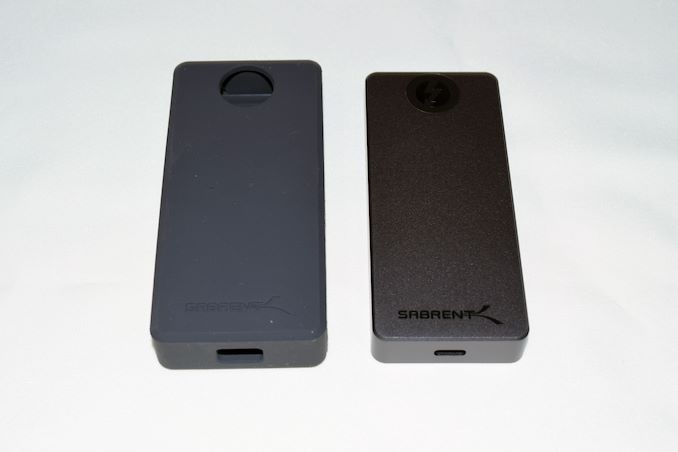Sabrent Rocket XTRM-Q USB / Thunderbolt 3 Dual Mode External SSD Review: Yin and Yang
by Ganesh T S on December 14, 2020 9:30 AM ESTDevice Features and Characteristics
Sabrent packs its drives into metal cases, delivering the look and feel of a premium product. Inside the box, we have the main SSD and a box containing the cables - a USB 3.2 Gen 2 Type-C to Type-A one, and a Thunderbolt 3 Type-C to Type-C one. A note with directions to change the caching policy for the drive is also included, as shown in the picture below.
The write-caching policy problem is an issue for all Thunderbolt 3 SSDs in the market, and is not restricted to the Sabrent Rocket XTRM-Q. Despite the provided directions, we evaluate all SSDs (including our DIY Thunderbolt 3 SSD using the TEKQ Rapide enclosure and the WD Black SN750) in the default state with write caching turned off - This ensures we are comparing apples to apples even when the units under consideration use different host interfaces.
The Sabrent Rocket XTRM-Q is bundled with the longest Thunderbolt 3 cable (70cm) we have seen so far in any Thunderbolt 3 SSD. Sabrent also provides optional shockproof protection in the form of bumpers for the XTRM-Q. At less than 130g, the drives are light but the aluminum enclosure lends solidity.
The table below compares the features and characteristics of the various SSDs dealt with in the review today.
| Direct-Attached Storage Characteristics | ||
| Aspect | ||
| Upstream Port | USB 3.2 Gen 2 and Thunderbolt 3 Type-C | USB 3.2 Gen 2 Type-C |
| Bridge / Controller | Intel JHL7440 + Phison E12S-based Sabrent Rocket Q | ASMedia ASM2362 + Silicon Motion SM2263 |
| Flash | Micron 96L 3D QLC | Micron 96L 3D QLC |
| Power | Bus Powered | Bus Powered |
| Physical Dimensions | 190 mm x 132 mm x 17.53 mm | 110 mm x 53 mm x 11.5 mm |
| IP Rating | N/A | N/A |
| Weight | 129 grams (without cable) | 101 grams (without cable) |
| Cable | ~50cm USB 3.2 Gen 2 Type-C to Type-A ~70cm Thunderbolt 3 (Type-C to Type-C) |
23 cm USB 3.2 Gen 1 Type-C to Type-C Type-C to Type-A adaptor bundled |
| S.M.A.R.T Passthrough | Yes | Yes |
| UASP Support | Yes | Yes |
| TRIM Passthrough | Yes | Yes |
| Encryption Support | N/A | N/A |
The Sabrent Rocket XTRM-Q is available in capacities ranging from 500GB (with a MSRP of $230) to 8TB (with a MSRP of $2000). This high capacity is achieves thanks to the use of Micron's 96L QLC NAND. QLC brings along a host of challenges related to endurance and slow write speeds. SSD vendors solve this by bringing in overprovisioning and SLC caching. Sabrent indicated that the XTRM-Q models come with around 9% over-provisioning out of the box. SLC cache size varies based on the drive capacity, and that is one of the aspects we evaluate further down in this review.













14 Comments
View All Comments
s.yu - Monday, December 14, 2020 - link
The greatest thing I learned from this article is that TB drives usually aren't backward compatible with USB, it never even came to me that that would be possible. Good thing I didn't buy a TB housing for my SSD which would've been quite a bit more expensive than the USB version.ballsystemlord - Monday, December 14, 2020 - link
@Ganesh Could you just create the tables without JS? They might list a lot of images, but at least it would all be there.KimGitz - Tuesday, December 15, 2020 - link
I have been hoping to see this dual operation on audio interfaces. With Thunderbolt 4 and USB 4 offering the same bandwidth the fall back from Thunderbolt to USB would offer similar performance and features using the Jhl8440 Goshen Ridge Controller. I think all docks and peripherals in future should just support Thunderbolt 4 and USB4 dual use.Deicidium369 - Wednesday, December 16, 2020 - link
That's the point of TB4 - which is just a certification by Intel that both the TB3 and USB4 are implementing the whole spec for both. TB4 is TB3 - 40Gb/s... So by definition a TB4 is an Intel certified TB3 + USB4 system.